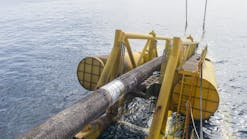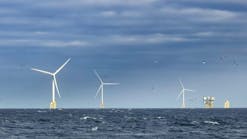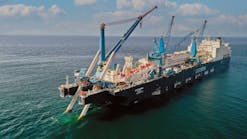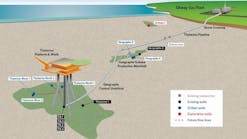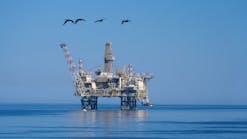Newfoundland looks for the next big discovery
Judy Maksoud
International Editor
Newfoundland is looking to deepwater for discoveries that will sustain the offshore industry. The White Rose project is moving forward, but there are no other development projects in the works. The oil and gas industry in the province cannot afford to lose momentum. At present, the biggest threat to Newfoundland's offshore is inertia.
The Terra Nova field in the Jeanne d'Arc basin began producing last January. Today, the field produces 130,000 b/d, up from the startup level of 125,000 b/d. According to Gary Bruce, vice president of Petro-Canada's offshore development and operations, Terra Nova is expected to produce at this rate for another 13-14 years. Meanwhile, the nearby Hibernia field, which began production in November 1997, is being produced from the Hibernia platform and is expected to produce from the known reserves base for another 12 years.
Hibernia produced an average of 170,000 b/d in 2002. The Canada-Newfoundland Offshore Petroleum Board has placed estimated recoverable reserves for the Hibernia and Avalon reservoirs at 884 MMbbl, and the field has substantial potential in terms of satellite production. Until that potential is realized, the Hibernia Management & Development Co. is looking for ways to increase peak capacity and to improve capacity utilization. HMDC is jointly run by the field's six partners. ExxonMobil is the largest shareholder with 33.1%. Other partners are ChevronTexaco with 26.9%, Petro-Canada with 20%, Canada Hibernia Holding Corp. with 8.5%, Murphy Oil with 6.5%, and Norsk Hydro with 5% interest.
Reportedly, the group is considering intelligent completions as one means of controlling water injection on a zone-by-zone basis, using the monitoring capability of Smart Well injectors to determine injection take points and sweep direction. At present, however, with no award made, intelligent manipulation of the reservoir will not make an immediate difference in production numbers.
Today, the biggest question for the Newfoundland offshore is, "What next?" According to David Hawkins, director of the petroleum resources development division of Newfoundland's Mini- stry of Mines and Energy, "Maintaining momentum is critical now. We need exploration. We need the next round of discoveries."
The need for new discoveries was echoed at the East Coast Canada Oil and Gas Exploration Seminar held in St. John's, Newfoundland, last November.
President and CEO of Newfoundland Ocean Industries Association Leslie Galway emphasized the potential for Newfoundland's offshore. Atlantic Canada is a strong and growing frontier, Galway said, but there is an enormous offshore area that has never seen the drill bit.
"We're very much under-explored," she said.
Over $4 billion has been spent on drilling alone offshore Newfoundland since the 1960s, according to Galway. With the Hibernia and Terra Nova fields in production and White Rose scheduled to come onstream in 2005, Newfoundland has established itself as an oil and gas province. With no commercial discoveries since the 1980s, however, the province is looking forward to additional exploration drilling in the near future.
In 2001, the boundary dispute between Nova Scotia and Newfoundland was officially resolved, freeing up acreage in the Laurentian basin. Boundary resolution paves the way for permits in the area to be converted into licenses, according to Hawkins. The only hold-up, he said, would be federal government regulations. Unfortunately, the province cannot easily accommodate a hiatus in activity, and the mood of local government and industry is one of anticipation.
Ironing out legislative issues is critical because once legislation is passed, work can begin on the blocks. That cannot happen quickly enough to suit Newfoundlanders.
"We're anxiously, anxiously, anxiously awaiting new leases in the Laurentian basin," Galway said.
Certainly, the province's best hope for better days is the development of its offshore hydrocarbon reserves.
Derek Evoy, Petro-Canada's manager of exploration of the East Coast and frontiers, pointed to 3D seismic surveying that has been completed in the Jeanne d'Arc basin and the Flemish Pass as incentives for drilling. The new data significantly improves reservoir and trap mapping, increases prediction accuracy, and makes better basin modeling possible, Evoy said. "Though exploration always brings huge risk with it," Evoy said, "3D seismic increases the possibility of success."
Despite these increased chances of finding hydrocarbons, recent drilling has not revealed the elephants that many believe lurk beneath the Atlantic Canadian coast. The lack of recent successes, however, has not entirely deterred exploration. After all, there is always a chance of a discovery that can be tied in to an existing development. Even in the absence of stand-alone fields, the value of add-on fields cannot be overlooked, Evoy said.
Still an area for growth
Though no developments are on the horizon at present, Atlantic Canada is one of six primary growth areas for EnCana, according to John Hogg, the company's vice president of Atlantic Canada exploration.
EnCana will pursue exploration off East Canada this year, but the company is not planning gas exploration off Newfoundland, Hogg said, because it is too hard to produce. In fact, the difficulty of turning discoveries into producing fields is a major obstacle in the region. Many of those difficulties stem from location and environment. The sea state is a concern from October to March, Hogg said, with pack ice and icebergs threatening from February through July. The Guinness World Book of Records calls the Grand Banks the foggiest place on earth. During winter, there is 40% fog coverage, increasing to 84% in June and July. The distance from exploration basins to shore, which Hogg placed at 220-550 km, is another considerable factor.
In addition to these impediments, Hogg cited the cost of doing business and "regulatory intenseness" as hurdles. The costs for a driller to work off Eastern Canada has been estimated as high as $8 per second. With costs this high, the potential for success has to be great.
An equally significant factor is reservoir complexity, which became a critical issue that led to the postponement early last year of the Hebron/Ben Nevis development in the Jeanne d'Arc basin. Though the combined estimated resources were placed at 400 MMbbl, the project was shelved by partners ChevronTexaco, ExxonMobil, Norsk Hydro, and EnCana, who determined it was not economically viable.
Despite obstacles and impediments, EnCana has not been put off by the cold reality of exploration in Atlantic Canada. The company plans to drill four to six wells in Atlantic Canada this year.
"The potential for discoveries off Nova Scotia and Newfoundland is great," Hogg said.
And that potential is enough to keep not only EnCana's interest, but other significant investors.
Norsk Hydro is among the companies actively looking into exploration potential off Newfoundland. The company holds a 15% interest in the Terra Nova project, which produced first oil in January 2002, and 5% of Hibernia, which has been producing since late 1997. According to Anders Kullerud, vice president of operations and field development, Atlantic Canada's offshore has "huge resource potential." Norsk Hydro wants to secure a large stake in new discoveries in the region, Kullerud said.
Current drilling
Hopes are high that one of the new regions will give encouraging signs soon. Ocean Rig's Eirik Raude semisubmersible moved to license EL 1049 in the Flemish Pass on Feb. 7, 2003, and spudded Mizzen L-11, the first deepwater well on the prospect, the following day. A lot of hopes are pinned on the deepwater exploration, which is being closely watched by oil and gas industry personnel in the province.
While the first exploration wells of the year are spudded, the White Rose development is making progress. There has been rapid activity on White Rose since EnCana and Husky Oil's announcement in March 2002 that the project would be developed.
An FPSO will produce the field with a peak production rate of about 100,000 b/d of oil. Work on the hull and the topsides is well underway. Detailed engineering for the FPSO is in progress, as is the subsea detailed engineering element of the project. Glory hole excavation began last August and will be resumed this year. According to William Roach, Husky's general manager of East Coast development, the project is running smoothly and on schedule.
Current plans provide for a total of 19 to 21 wells to recover between 200 and 250 MMbbl of oil over a 10-15 year period. Peak production is expected to be approximately 92,000 b/d sustained over four years. First oil is expected by the end of 2005.
Dynamic CNG test facility in the making
In June 2002, Enersea Canada and the Memorial University in St. Johns, Newfoundland, formed a partnership to build a fully dynamic compressed natural gas (CNG) testing facility in St. John's.
According to Enersea Canada President Stephen Henley, Newfoundland is the perfect location for the new CNG Centre of Excellence.
"The depth of maritime experience coupled with applied engineering resident here is world class," he said.
The primary objective is to accelerate the development of novel CNG marine transport concepts by performing comprehensive system and equipment testing in real-world conditions, something that until now has not existed elsewhere.
"The CNG testing facility will be unique and innovative," Henley said.
The facility is still in the planning stages, but when it is completed, it will be capable of testing systems on a large scale in realistic gas transportation conditions. The conditions will cover offshore platform loading to marine transport to inshore or offshore offloading.
The joint project has lofty goals. When the facility is fully operational, organizers intend for it to provide world-class research and development for safe and competitive marine transportation, storage, handling and usage of CNG.
"It will be an open-access facility to all CNG technology providers or end users," Henley said.
A primary goal is to confirm the viability of marine CNG transport for Atlantic Canada and the world. And that is important, Henley said, because CNG transport provides a means of monetizing stranded gas.
"Creating the CNG Centre of Excellence demonstrates the importance of CNG to the future of Atlantic Canada's offshore and other stranded gas regions," Henley said. Commercializing currently uneconomic natural gas, particularly reserves located in the Grand Banks region, is critical for the province. With no new discoveries and no development projects on the books after White Rose, the future of the offshore industry would be brighter if CNG technology were able to move gas to market.
The creation of this facility is indicative of acceptance by industry, government, and the community of the vital role CNG transportation can play, he said.
Potential projects for the facility are many. Henley pointed to offshore gas treatment technology validation and gas compositional analysis as possible services. System transients modeling and dynamic simulation will also be provided. The center will be positioned to test CNG-related equipment for maritime and offshore service. In addition, the center and its collaborators will develop "best practices" guidance as well as safety practices for gas handling systems and marine transportation, loading/offloading, and storage systems.
Newfoundland's offshore basins.
null
Oil and gas development partnership
The Oil and Gas Development Partnership was created three years ago as a collaborative effort on the part of the Memorial University of Newfoundland, the oil and gas industry, associated service companies, and government agencies.
Memorial University was selected for this partnership on the basis of the university's position as a leader in the earth sciences and harsh, cold environment engineering studies. Now, two new areas of innovative research are being undertaken, one in reservoir characterization and management and the other in asset integrity management. With the introduction of the master of oil and gas studies in September 2003, Memorial University will be in the forefront of executive education for high potential employees of the oil and gas industry.
According to Gerit Maureau, executive director of the Oil and Gas Development Partnership at the university, the oil and gas studies program will be holistic and cross-cultural. "We want this to be a technicolor program," he said, explaining that the course of study will include regulatory, environmental, engineering, geosciences, and cultural components. Instruction will come not only from academia, but also from government and industry, Maureau said.
In creating this program, Memorial University has moved away from education that Maureau called "purely theoretical," and into a realm that provides a "multi-disciplinary approach to problem solving, akin to the 'asset management' team approach used the industry," Maureau said.
The objective in offering the new program alongside other specific programs particular to the oil and gas industry is to provide a broad knowledge that the more focused programs lack.
In the end, the clear goal is to transform Newfoundland into a world leader in education, training, research, and development so that the benefits of the offshore oil and gas industry do not bypass the province.


